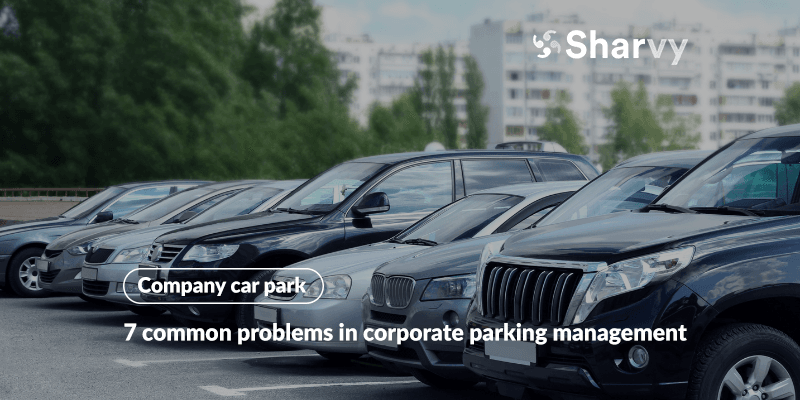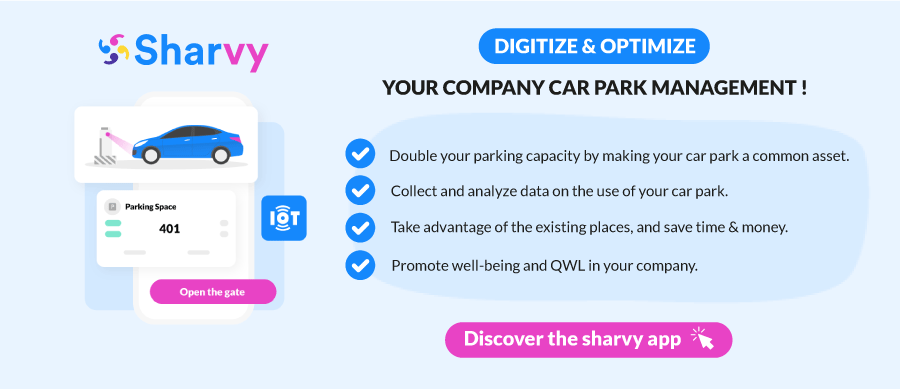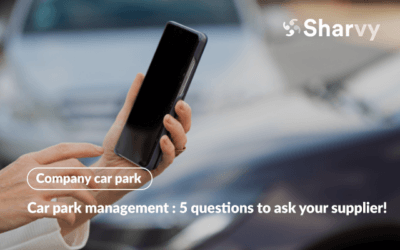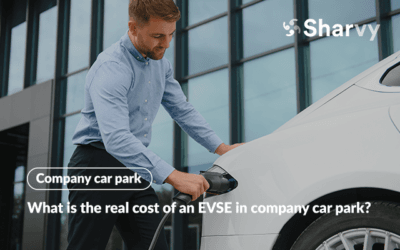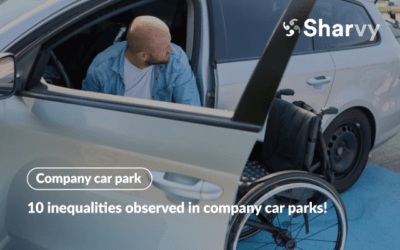The issues surrounding car park management and optimization are now non-negligible in many respects.
For many employees, the company car park is the entry point to their working environment. For visitors, it is often their first contact with the company they are visiting. That’s why it’s vital to tackle the issue of company car park management head-on.
This task can quickly become complex on a day-to-day basis, especially for the person in charge of the car park management. In this article, discover 7 recurring problems we observe among our customers and the keys to solving them!
1. There are not enough places for all employees !
Although the employer is not obligated to offer a dedicated seat to each employee, the best thing to do is share them with all employees. With teleworking, travel, annual holidays, etc. You will rarely, if ever, see all your employees on-site simultaneously.
Moreover, with people coming by public transport, on foot, or carpooling, for example, the number of spaces needed is even smaller. Of course, this depends on where your company is based. In the Paris region, where public transport is highly favored, the number of employees in one space may be higher than for a company based in a medium-sized town, where private cars are more widely used.
At the same time, consider encouraging your employees to use alternative modes of transport, for example, by advertising car-pooling, reimbursing all or part of public transport season tickets, etc. This way, fewer employees will need a parking space, limiting the problem. However, if parking problems persist, discover 5 solutions right here!
Another solution is to rent spaces in a nearby car park. But this comes at a significant cost. On average, you were renting a space costs between €1,500 and €2,000 a year. So before you invest in additional parking spaces, use our white paper to check whether you’ve made the necessary optimizations to your company car park.
2. Many assigned spaces are unoccupied every day
Generally, company car parks operate with an allocation of free spaces and allocated spaces. However, if the holder of the space is absent one day due to teleworking, travel or simply holidays, the space remains unused without any possibility for other employees to use it. This can lead to frustration for the employee who will not have any parking spaces but will see available but inaccessible spaces.
To remedy this problem, you have two solutions :
- Remove all the named spaces and make them all freely accessible : this is not the option we recommend, as it is difficult to remove the parking space of a director or a member of the Comex.
- Make your company car park a shared asset and manage it collaboratively : in other words, share parking spaces between your employees. The aim is to set up a system that allows a car park owner to declare the days when they will not be using the space and allows an employee to reserve it. This type of solution can be created in-house. However, it will quickly become time-consuming and burdensome for the person in charge. The best option is a dedicated solution that centralizes requests and automatically allocates places, as Sharvy does! An application that also promotes smart mobility and sustainable mobility within companies.
3. Access control to the car park raises many security issues
Access control is an essential issue for any company. Without a car park access control system, it can be tempting for people outside the company to gain access and occupy the spaces reserved for employees. Nor does it prevent them from vandalizing or stealing vehicles and/or equipment in the car park. So, to deter this type of crime and avoid any risk of incident, it’s essential to secure access to your company car park.
This is all the more critical when the company car park is underground, as it is an entry point to the company. So it’s essential to control who comes in and who goes out.
That’s why having a gate, a security barrier, and/or a retractable access control bollard is an essential first step. In addition to this installation, you can consider a human presence, with a reception desk and a guard/supervisor who controls incoming and outgoing flows and prevents malicious acts. The major, if not the only, disadvantage of this solution is its cost since, to be effective, this surveillance must be carried out 24 hours a day, 7 days a week.
Another solution is to consider access control via RFID readers and badges. However, this may not be the best solution because of the many losses, thefts, breakages, exchanges, and lack of flexibility that this entails. These non-dematerialized systems can, therefore, lead to various security problems.
The best access control solutions are still paperless and allow the barrier to be opened only if the person has a named or reserved place on the day. This is particularly the case with plate recognition cameras. They know the number plate before the barrier and will automatically open it. Moreover, this solution is much more flexible and less time-consuming for facility managers or those in charge of the car park management.
4. Multi-site parking management is a real headache
The most complicated thing when a company has several sites is to harmonise the management of these sites in order to facilitate the mobility of employees. Indeed, an employee who moves to another site must not feel lost and must be able to find his or her bearings easily. This means having a single management system for all sites, and a single access control system. And this obviously involves harmonised management of all its car parks.
And to answer this question, digital solutions are perfect: an employee will be able to come and go between the different sites of the company very easily, and thus keep his habits. Moreover, it saves time for the company, which will not have to create temporary badges to access the spaces, or deal with emails requesting spaces or access…
5. Management company car park is time consuming
Finally, parking management can be very time-consuming for the person in charge of this mission. Indeed, between visitor access requests, employees needing a space, company turnover which implies redistributing the available spaces… the task can quickly become difficult to manage and time-consuming.
Some companies decide to build in-house solutions such as Excel spreadsheets to manage the allocation of spaces. But this is time consuming and needs to be updated regularly. At Sharvy, and other similar companies, we offer a turnkey digital solution where employees can reserve or release their spaces in 2 clicks via a web and mobile application. Spaces are then allocated automatically according to pre-defined priority rules. No action on the part of the team in charge of the parking management is necessary, which represents a significant time saving for them.
6. Conflicts between employees over the use of parking spaces.
In many companies, parking can quickly become a source of tension if clear rules are not in place.
Just imagine: an employee arrives in the morning to discover that his allocated space is occupied. This is followed by tense exchanges and frustrations which, over time, can affect the working atmosphere.
Others find themselves walking in circles for precious minutes, hoping to find a free seat. These avoidable situations are a reminder of the importance of implementing a transparent and fair parking policy in your company car park. With smart parking solutions like Sharvy, you can anticipate and avoid such friction.
7. The environmental impact of a poorly optimised car park
Apart from the day-to-day inconvenience, poorly designed company car parks also have an environmental cost.
Constant lighting for half-empty areas, cars turning unnecessarily in search of a space, and the lack of options for electric vehicles all contribute to an ecological footprint that could be reduced.
What’s more, without incentives for company car-sharing and the use of alternative modes of transport, parking becomes a mere extension of polluting habits.
However, with a little effort, these spaces can become levers for more sustainable practices, such as providing recharging points and prioritising spaces for carpoolers. Measures to create an environmentally-friendly company car park that can easily be implemented with a Parking Management solution like Sharvy.
A real asset for companies concerned about their environmental responsibility.
In conclusion
In short, exploring the issues inherent in company car parks reveals numerous logistical and human challenges, requiring a considered and strategic approach for effective resolution. Congestion, lack of access to soft mobility, and inadequate facilities to meet new working standards are all obstacles that, if neglected, can significantly impact operational efficiency and employee well-being.
Against this backdrop, optimizing company car parks is an urgent necessity. Thoughtful management of these spaces not only helps to resolve these operational issues but is also part of building a professional environment conducive to productivity, employee satisfaction and loyalty, and the achievement of organizational objectives.
Have a question? Check out the FAQ!
How can a company optimise the use of parking spaces for all employees?
To optimise the use of parking spaces, it’s essential to manage the car park collaboratively. One solution is to implement a system that allows space holders to declare the days they won’t use their space, so other employees can reserve them. Using a dedicated application facilitates this management by centralising requests and automatically allocating available spaces, reducing frustrations and optimising car park occupancy.
What measures can be taken to improve the security of the company car park?
Several measures can be implemented to improve the security of the company car park. Installing gates, security barriers, and access control points is a first step. Human surveillance, such as a security guard, can also be considered to monitor entries and exits. Dematerialised access control systems, such as licence plate recognition cameras, offer a flexible and less time-consuming solution, allowing for secure and efficient car park access management.
How can a company solve the issue of insufficient parking spaces for its employees?
To solve the issue of insufficient parking spaces in a company, adopting a collaborative approach is essential. An effective solution is to use a dedicated app like Sharvy, which allows employees to reserve or release spots based on their presence. This method ensures an optimal distribution of parking spaces, reducing frustrations and increasing occupancy rates. Additionally, the company can promote alternative mobility solutions, such as carpooling or the use of electric vehicles, which helps reduce the demand for parking spaces. If the problem persists, the company might also consider renting additional spots in nearby parking lots to meet the demand.
Want to learn more? Check out our latest articles!
Car park management : 5 questions to ask your supplier!
Are you looking for a digital solution for car park management? Here are 5 pertinent questions to ask your supplier!
What is the real cost of an EVSE in a company car park?
Are you thinking of installing charging points in your company car park? But how much does an EVSE installation cost? Focus!
10 inequalities observed in company car parks!
What inequalities can be observed in company car parks? What impact do they have? What can be done about them? Find the answers here!
Subscribe to our newsletter!
Resources
Contact us
+44 117 463 6990

